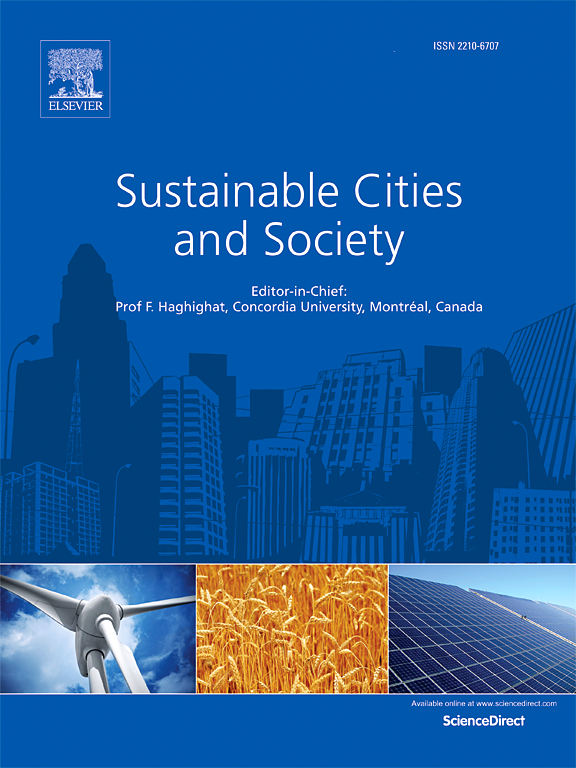中国东部PM2.5污染波与寒潮的联合健康风险
IF 10.5
1区 工程技术
Q1 CONSTRUCTION & BUILDING TECHNOLOGY
引用次数: 0
摘要
基于2008-2018年收集的1800669份死亡记录,我们估算了中国东部地区空气污染波和寒潮共同影响下的死亡风险,并确定了脆弱亚群。在这里,空气污染波定义为每日平均细颗粒物超过阈值(P1/P2/P3/P4: 75/115/120/150 μg/m3)至少两天。寒潮定义为每日平均温度低于阈值(T1/T2/T3:第10 /5 /2.5个百分点)至少两天。采用准泊松回归模型结合分布滞后线性模型对城市联合效应进行了估计。以P4T3定义时,全因死亡率的最高总相对危险度为2.07 (95% CI: 1.73 ~ 2.48)。相互作用导致的相对过量风险在苏州最强(P3T3, 4.25, 95% CI: 3.45-5.23)。一般来说,心血管疾病、呼吸系统疾病、精神和行为障碍疾病的死亡率较高。此外,女性、老年、未婚、高学历人群以及沿海和南方城市居民更容易受到联合事件的影响。这些发现对于制定地方卫生和气候政策以减少气候变化下极端天气和空气污染对健康的影响至关重要。本文章由计算机程序翻译,如有差异,请以英文原文为准。
The joint health risks of PM2.5 pollution wave and cold spell in eastern China
Based on 1800,669 mortality records collected during 2008–2018, we estimated the mortality risk and identified the vulnerable subpopulations of joint effects of the air pollution wave and the cold spell in eastern China. Here, air pollution waves were defined as daily mean fine particulate matter higher than a threshold (P1/P2/P3/P4: 75/115/120/150 μg/m3) for at least two days. Cold spells were defined as daily mean temperature below a threshold (T1/T2/T3: 10th/5th/2.5th percentile) for at least two days. A quasi-Poisson regression model combined with a distributed lag linear model was used to estimate the city-specific joint effects. When defined by P4T3, the highest pooled relative risks 2.07 (95 %CI: 1.73–2.48) of all-cause mortality was discovered cross Jiangsu province. The strongest relative excess risk due to interaction were observed in Suzhou (P3T3, 4.25, 95 %CI: 3.45–5.23). Generally, higher mortality risks were in cardiovascular disease, respiratory disease, and mental and behavior disorders disease. Moreover, the female, elderly, not married, and higher educated individuals and the residents in coastal and southern cities were more vulnerable to joint events. These findings are crucial for the development of local health and climate policies to reduce the health impacts of extreme weather and air pollution under climate change.
求助全文
通过发布文献求助,成功后即可免费获取论文全文。
去求助
来源期刊

Sustainable Cities and Society
Social Sciences-Geography, Planning and Development
CiteScore
22.00
自引率
13.70%
发文量
810
审稿时长
27 days
期刊介绍:
Sustainable Cities and Society (SCS) is an international journal that focuses on fundamental and applied research to promote environmentally sustainable and socially resilient cities. The journal welcomes cross-cutting, multi-disciplinary research in various areas, including:
1. Smart cities and resilient environments;
2. Alternative/clean energy sources, energy distribution, distributed energy generation, and energy demand reduction/management;
3. Monitoring and improving air quality in built environment and cities (e.g., healthy built environment and air quality management);
4. Energy efficient, low/zero carbon, and green buildings/communities;
5. Climate change mitigation and adaptation in urban environments;
6. Green infrastructure and BMPs;
7. Environmental Footprint accounting and management;
8. Urban agriculture and forestry;
9. ICT, smart grid and intelligent infrastructure;
10. Urban design/planning, regulations, legislation, certification, economics, and policy;
11. Social aspects, impacts and resiliency of cities;
12. Behavior monitoring, analysis and change within urban communities;
13. Health monitoring and improvement;
14. Nexus issues related to sustainable cities and societies;
15. Smart city governance;
16. Decision Support Systems for trade-off and uncertainty analysis for improved management of cities and society;
17. Big data, machine learning, and artificial intelligence applications and case studies;
18. Critical infrastructure protection, including security, privacy, forensics, and reliability issues of cyber-physical systems.
19. Water footprint reduction and urban water distribution, harvesting, treatment, reuse and management;
20. Waste reduction and recycling;
21. Wastewater collection, treatment and recycling;
22. Smart, clean and healthy transportation systems and infrastructure;
 求助内容:
求助内容: 应助结果提醒方式:
应助结果提醒方式:


